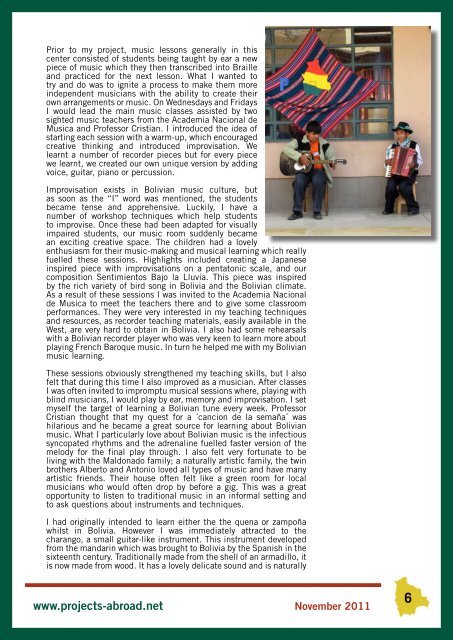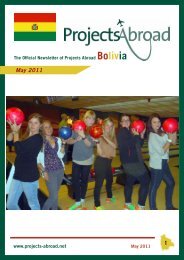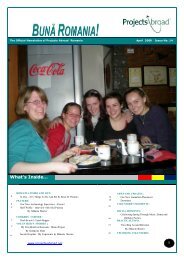Bo liv ia - Projects Abroad
Bo liv ia - Projects Abroad
Bo liv ia - Projects Abroad
You also want an ePaper? Increase the reach of your titles
YUMPU automatically turns print PDFs into web optimized ePapers that Google loves.
Prior to my project, music lessons generally in this<br />
center consisted of students being taught by ear a new<br />
piece of music which they then transcribed into Braille<br />
and practiced for the next lesson. What I wanted to<br />
try and do was to ignite a process to make them more<br />
independent music<strong>ia</strong>ns with the ability to create their<br />
own arrangements or music. On Wednesdays and Fridays<br />
I would lead the main music classes assisted by two<br />
sighted music teachers from the Academ<strong>ia</strong> Nacional de<br />
Musica and Professor Crist<strong>ia</strong>n. I introduced the idea of<br />
starting each session with a warm-up, which encouraged<br />
creative thinking and introduced improvisation. We<br />
learnt a number of recorder pieces but for every piece<br />
we learnt, we created our own unique version by adding<br />
voice, guitar, p<strong>ia</strong>no or percussion.<br />
Improvisation exists in <strong>Bo</strong><strong>liv</strong><strong>ia</strong>n music culture, but<br />
as soon as the “I” word was mentioned, the students<br />
became tense and apprehensive. Luckily, I have a<br />
number of workshop techniques which help students<br />
to improvise. Once these had been adapted for visually<br />
impaired students, our music room suddenly became<br />
an exciting creative space. The children had a lovely<br />
enthus<strong>ia</strong>sm for their music-making and musical learning which really<br />
fuelled these sessions. Highlights included creating a Japanese<br />
inspired piece with improvisations on a pentatonic scale, and our<br />
composition Sentimientos Bajo la Lluv<strong>ia</strong>. This piece was inspired<br />
by the rich variety of bird song in <strong>Bo</strong><strong>liv</strong><strong>ia</strong> and the <strong>Bo</strong><strong>liv</strong><strong>ia</strong>n climate.<br />
As a result of these sessions I was invited to the Academ<strong>ia</strong> Nacional<br />
de Musica to meet the teachers there and to give some classroom<br />
performances. They were very interested in my teaching techniques<br />
and resources, as recorder teaching mater<strong>ia</strong>ls, easily available in the<br />
West, are very hard to obtain in <strong>Bo</strong><strong>liv</strong><strong>ia</strong>. I also had some rehearsals<br />
with a <strong>Bo</strong><strong>liv</strong><strong>ia</strong>n recorder player who was very keen to learn more about<br />
playing French Baroque music. In turn he helped me with my <strong>Bo</strong><strong>liv</strong><strong>ia</strong>n<br />
music learning.<br />
These sessions obviously strengthened my teaching skills, but I also<br />
felt that during this time I also improved as a music<strong>ia</strong>n. After classes<br />
I was often invited to impromptu musical sessions where, playing with<br />
blind music<strong>ia</strong>ns, I would play by ear, memory and improvisation. I set<br />
myself the target of learning a <strong>Bo</strong><strong>liv</strong><strong>ia</strong>n tune every week. Professor<br />
Crist<strong>ia</strong>n thought that my quest for a ´cancion de la semaña´ was<br />
hilarious and he became a great source for learning about <strong>Bo</strong><strong>liv</strong><strong>ia</strong>n<br />
music. What I particularly love about <strong>Bo</strong><strong>liv</strong><strong>ia</strong>n music is the infectious<br />
syncopated rhythms and the adrenaline fuelled faster version of the<br />
melody for the final play through. I also felt very fortunate to be<br />
<strong>liv</strong>ing with the Maldonado family; a naturally artistic family, the twin<br />
brothers Alberto and Antonio loved all types of music and have many<br />
artistic friends. Their house often felt like a green room for local<br />
music<strong>ia</strong>ns who would often drop by before a gig. This was a great<br />
opportunity to listen to traditional music in an informal setting and<br />
to ask questions about instruments and techniques.<br />
I had originally intended to learn either the the quena or zampoña<br />
whilst in <strong>Bo</strong><strong>liv</strong><strong>ia</strong>. However I was immed<strong>ia</strong>tely attracted to the<br />
charango, a small guitar-like instrument. This instrument developed<br />
from the mandarin which was brought to <strong>Bo</strong><strong>liv</strong><strong>ia</strong> by the Spanish in the<br />
sixteenth century. Traditionally made from the shell of an armadillo, it<br />
is now made from wood. It has a lovely delicate sound and is naturally<br />
www.projects-abroad.net November 2011<br />
6





